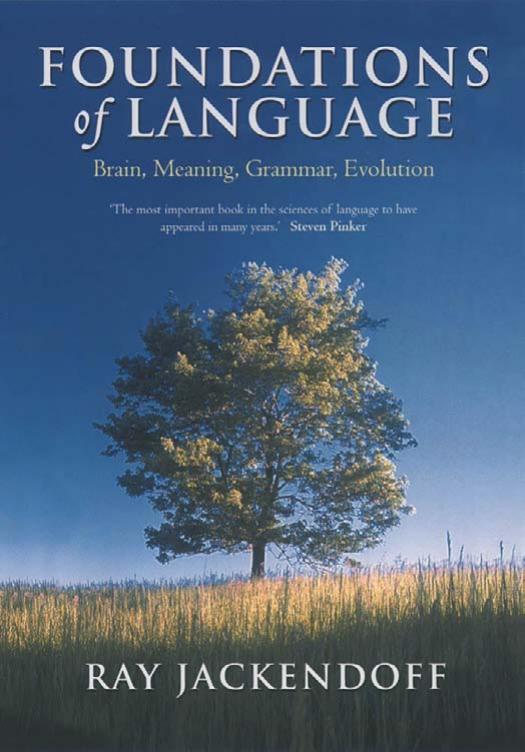Foundations of Language: Brain, Meaning, Grammar, Evolution by Ray Jackendoff

Author:Ray Jackendoff [Jackendoff, Ray]
Language: eng
Format: epub, mobi, pdf
Tags: Oxford University Press, ISBN-13: 9780199264377, USA
Published: 2010-12-30T16:57:35.515000+00:00
234
ARCHITECTURAL FOUNDATIONS
possible alternative to natural selection, “principles of neural organization that may be even more deeply grounded in physical law.” Perhaps Chomsky's most famous quote about evolutionary argumentation is this one (among several cited in Newmeyer 1998a):
We know very little about what happens when 1010 neurons are crammed into something the size of a basketball, with further conditions imposed by the specific manner in which this system developed over time. It would be a serious error to suppose that all properties, or the interesting properties of the structures that evolved, can be
‘explained’ in terms of natural selection. (Chomsky 1975: 59)
As Toulmin (1972), Newmeyer (1998a), and Dennett (1995) point out, this is virtually a retreat to mysticism, appealing to the simple increase in brain size plus the convergence of unknown physical principles. We must not discount the possibility that Chomsky is right; but surely it is worth attempting to make use of the tools at our disposal before throwing themaway.
Piattelli-Palmerini (1989) argues, along more evolutionarily defensible lines, that language is nothing but a “spandrel” in the sense of Gould and Lewontin (1979).118 In his scenario, a number of unrelated developments motivated by natural selection coincidentally converged on a brain structure that happened to instantiate UG, which itself was not selected for. A similar hypothesis appears in Toulmin (1972: 459): “the physiological prerequisites of language developed, in proto-human populations, in a manner having nothing whatever to do with their subsequent ‘linguistic’ expression.”
Toulmin ends up hoping that “language might then turn out to be the behavioural end-product, not of a unitary and specific ‘native capacity’ precisely isomorphic with our actual linguistic behaviour, but rather of more generalized capacities” (465). That is, he specifically wishes to deny the UG hypothesis. As Newmeyer (1998a) points out, one cannot both have a specialized eccentric UG, as Piattelli-Palmerini would like, and claim that it is merely a consequence of general capacities, as Toulmin would like.
Chomsky, Piattelli-Palmerini, and Toulmin all are in effect taking the position that UG was not something that natural selection directly shaped—that it is in some way just a fortunate accident. The former two are using this position to answer the critics of UG; Toulmin is using a similar position to deny a special UG. Without further evidence, then, this argument is a standoff.
Pinker and Bloom(1990) argue for a different position: that the communicative
118 Dennett (1995) observes that Gould and Lewontin's use of the term “spandrel” is not analogous to the architectural sense of the termon which they claimto draw.
However, the termhas taken on its own life in evolutionary theory, like “Universal Grammar” in linguistics, so I suppose we have to live with it.
Download
Foundations of Language: Brain, Meaning, Grammar, Evolution by Ray Jackendoff.mobi
Foundations of Language: Brain, Meaning, Grammar, Evolution by Ray Jackendoff.pdf
This site does not store any files on its server. We only index and link to content provided by other sites. Please contact the content providers to delete copyright contents if any and email us, we'll remove relevant links or contents immediately.
Rewire Your Anxious Brain by Catherine M. Pittman(18555)
Talking to Strangers by Malcolm Gladwell(13236)
The Art of Thinking Clearly by Rolf Dobelli(10235)
Mindhunter: Inside the FBI's Elite Serial Crime Unit by John E. Douglas & Mark Olshaker(9214)
Becoming Supernatural by Dr. Joe Dispenza(8127)
Change Your Questions, Change Your Life by Marilee Adams(7641)
Nudge - Improving Decisions about Health, Wealth, and Happiness by Thaler Sunstein(7622)
The Road Less Traveled by M. Scott Peck(7525)
The Lost Art of Listening by Michael P. Nichols(7412)
Enlightenment Now: The Case for Reason, Science, Humanism, and Progress by Steven Pinker(7244)
Mastermind: How to Think Like Sherlock Holmes by Maria Konnikova(7234)
Win Bigly by Scott Adams(7099)
The Way of Zen by Alan W. Watts(6513)
Daring Greatly by Brene Brown(6451)
Big Magic: Creative Living Beyond Fear by Elizabeth Gilbert(5618)
Grit by Angela Duckworth(5526)
Ego Is the Enemy by Ryan Holiday(5298)
Men In Love by Nancy Friday(5162)
Altered Sensations by David Pantalony(5048)
